Freezing fails as bed bug treatment because your home freezer can’t maintain the required -16°C (3.2°F) for 80+ hours needed to kill all life stages. Most household freezers operate around -15°C with inconsistent temperatures due to door openings and poor air circulation. Thick materials prevent lethal temperatures from penetrating to inner bugs, while eggs show greater cold resistance than adults. Professional equipment offers the precise temperature control you’ll need for reliable elimination.
Understanding Bed Bug Cold Tolerance Capabilities
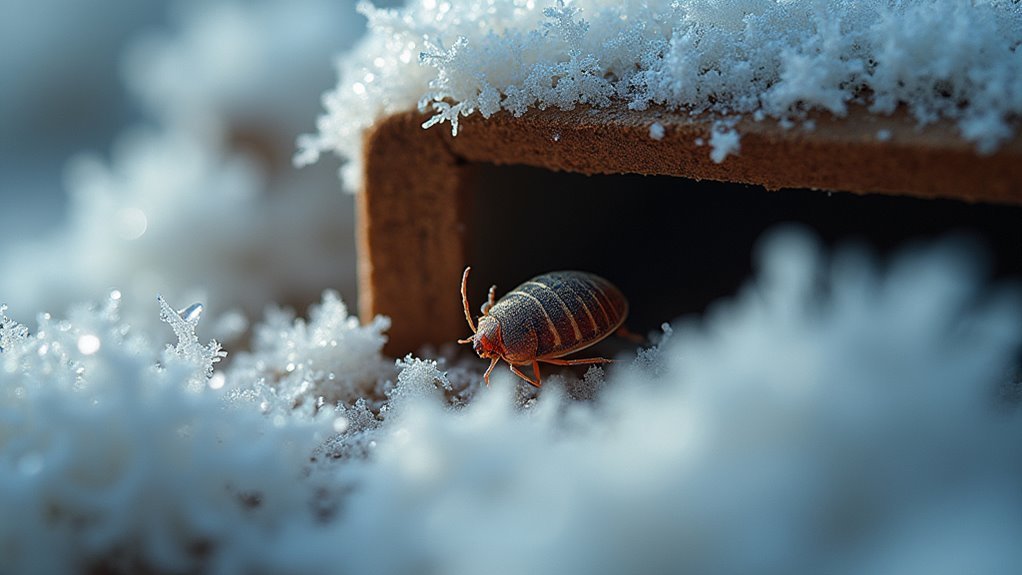
While many people assume that simply placing infested items in their home freezer will eliminate bed bugs, these resilient pests can actually survive short-term exposure to temperatures as low as -25°C (-13°F).
This remarkable cold tolerance makes freezing treatment far more complex than most homeowners realize. You’ll need sustained exposure at -16°C (3.2°F) for at least 80 hours to achieve complete mortality across all life stages.
Even at temperatures below -15°C (5°F), you’re looking at approximately 3.5 days of continuous cold exposure. The resilience of bed bug eggs presents an additional challenge, as they withstand colder temperatures better than adults.
Understanding these survival capabilities explains why casual freezing attempts often fail to eliminate infestations completely.
Temperature Requirements for Effective Bed Bug Elimination
You’ll need to expose bed bugs to temperatures below -16°C (3.2°F) to achieve complete elimination across all life stages.
The exposure time isn’t quick – you must maintain these freezing conditions for at least 80 hours to guarantee 100% mortality rates.
Your home freezer mightn’t reach these critical temperature thresholds, as many operate around -15°C (5°F), requiring extended treatment periods of 3.5 days or more.
Minimum Lethal Temperature Thresholds
Understanding the specific temperature thresholds required to kill bed bugs is essential for effective cold treatment, as these resilient pests can withstand surprisingly extreme conditions.
The minimum lethal temperature thresholds for bed bug treatments aren’t what you’d expect from typical freezer temperatures. While freezing bed bugs seems logical, the cold tolerance of bed bugs extends far beyond normal household capabilities.
You’ll need sustained temperatures of -16°C (3.2°F) for 80 hours to achieve complete mortality across all life stages. Even at -15°C (5°F), the required exposure time stretches to approximately 3.5 days.
Your standard home freezer simply won’t reach these critical thresholds consistently. Effective cold treatment demands specialized equipment and precise temperature control that most households lack, making this approach impractical for reliable elimination.
Extended Exposure Time Requirements
Extended exposure times become the determining factor between successful bed bug elimination and treatment failure.
You’ll need to maintain temperatures below -15°C for at least 3.5 days to achieve complete elimination across all life stages.
Even at colder freezing temperatures of -20°C, you’re still looking at a minimum 48-hour commitment.
The challenge intensifies when dealing with bed bug eggs, which can survive brief exposure to temperatures as low as -25°C.
Your treatment efforts become complicated because larger items require extended exposure time requirements to guarantee their cores reach lethal temperatures.
This means you can’t simply toss infested belongings into a freezer overnight and expect results.
The prolonged timeframes needed make freezing impractical for most household situations.
Home Freezer Limitations and Temperature Inconsistencies
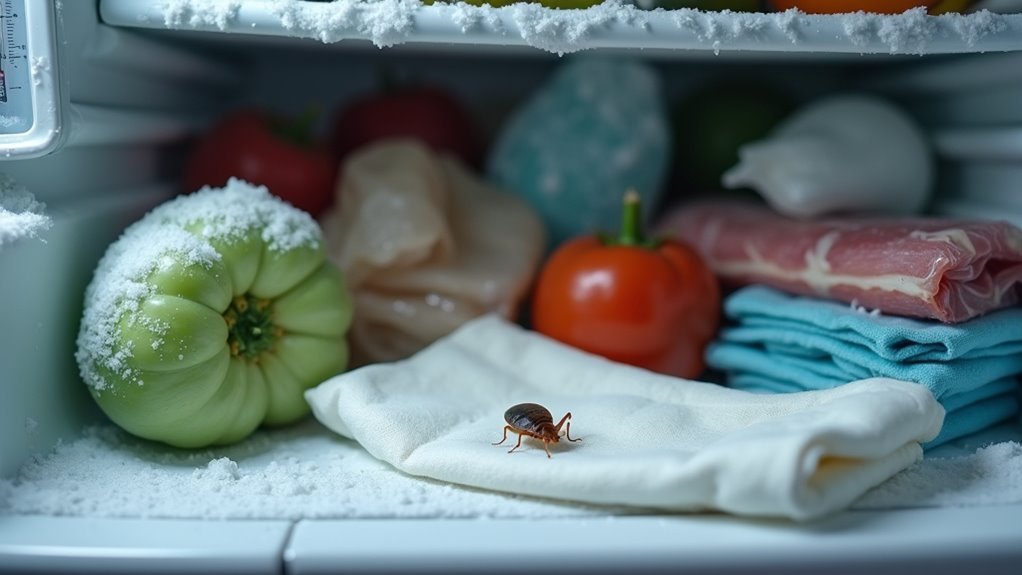
Your home freezer likely can’t maintain the consistent 0°F temperature needed to kill bed bugs throughout entire items.
The frequent door openings cause temperature fluctuations that create warm spots where bed bugs can survive.
You’ll also struggle with proper item placement, as thick comforters and shoes won’t freeze uniformly, leaving protected areas where bed bugs remain alive.
Inadequate Temperature Control
While many homeowners turn to their freezers as a potential bed bug solution, most residential units can’t achieve the extreme temperatures necessary for effective extermination. Your home freezers typically maintain inadequate temperature control around 0°F, which isn’t cold enough for complete eradication of bed bugs.
| Temperature | Exposure Time | Effectiveness |
|---|---|---|
| 0°F (typical home freezer) | Any duration | Insufficient |
| -13°F | Short-term | Bed bugs survive |
| 3.2°F | 80+ hours | 100% mortality |
The problem becomes worse when you place bed bug-infested items in your freezer. These items often don’t reach the required core freezing temperatures due to insulation effects. Without proper minimum exposure time at lethal temperatures, bed bugs will survive your freezing attempts, making this method unreliable for treatment.
Freezer Door Cycling
Even if your freezer reaches the necessary temperatures initially, frequent door cycling creates a significant obstacle to effective bed bug elimination.
Every time you open your home freezer, warm air rushes in and disrupts the consistent lethal temperatures needed for bed bug mortality. These temperature fluctuations can reset the clock on the required 80-hour exposure time.
Freezer door openings cause three major problems:
- Temperature spikes that interrupt the freezing process and allow bed bugs to survive
- Uneven cooling as items near the door experience the most dramatic temperature changes
- Extended treatment time since each warm air intrusion requires additional hours to restore proper conditions
Your regular kitchen activities fundamentally sabotage any bed bug treatment efforts in progress.
Item Placement Issues
Beyond temperature and timing challenges, how you place items in your home freezer directly impacts treatment success. Item placement issues create major obstacles for effective bed bug mortality. Your home freezers can’t achieve uniform cold temperatures throughout packed compartments, leaving warm spots where bugs survive. When you cram infested items together, air circulation becomes restricted, preventing proper heat transfer.
| What You Think Happens | What Actually Happens |
|---|---|
| All items freeze equally | Cold spots and warm zones form |
| Bugs die in hours | Survivors hide in insulated areas |
| Convenient home solution | Professional treatment needed |
| Money saved | Infestation continues spreading |
| Problem solved quickly | Months of ongoing issues |
Large infested items like comforters won’t fit properly, making freezing treatment ineffective for thorough bed bug elimination.
Penetration Problems With Thick Materials and Fabrics
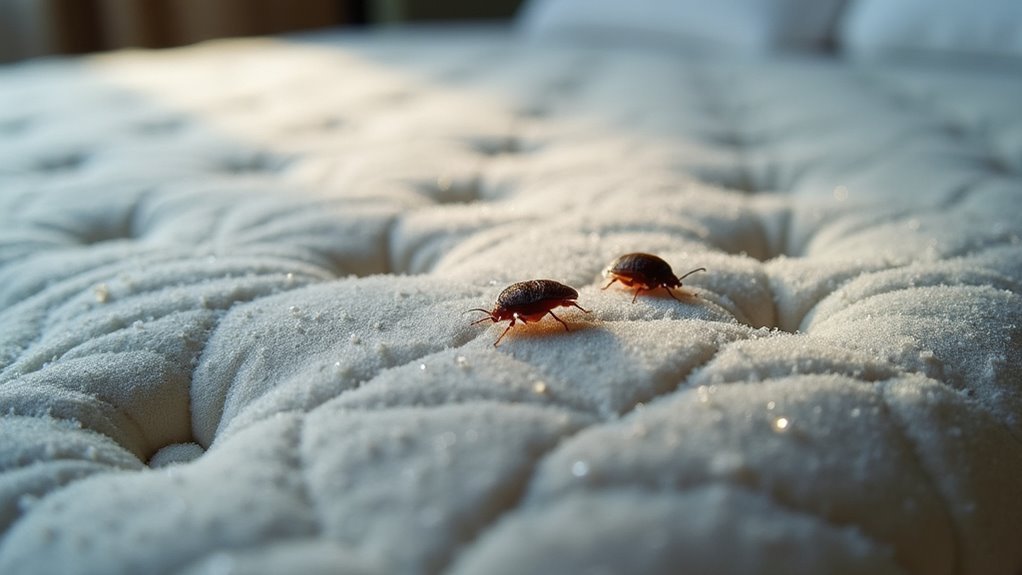
When you attempt freezing treatment on thick materials and fabrics, you’ll encounter significant penetration problems that can undermine the entire process. Thick materials create barriers that prevent freezing temperatures from reaching insulated bed bugs hidden deep within layers. Your bulky items like mattresses and upholstered furniture become protective shields for these pests.
The penetration challenges include:
Thick fabrics create impenetrable barriers that shield bed bugs from lethal freezing temperatures, making home treatment ineffective.
- Temperature requirements – You need 80 hours at -16°C for complete mortality, but thick fabrics prevent this from reaching the center.
- Insulation effects – Outer layers protect inner areas where bed bugs survive undetected.
- Extended timeframes – Semi-insulated items require up to two weeks of consistent below-freezing temperatures.
Your home freezer can’t maintain the necessary consistent temperatures to penetrate these materials effectively.
Time Duration Challenges for Complete Mortality
You’ll need to expose bed bugs to freezing temperatures for at least 80 hours at -16°F to achieve complete mortality across all life stages.
Your home freezer likely won’t maintain the consistently low temperatures required for effective treatment, even when running at maximum settings.
You must guarantee infested items remain frozen for a minimum of four days, though larger items may require extended exposure times to penetrate their core temperatures.
Minimum Exposure Requirements
Although freezing temperatures can effectively eliminate bed bugs, achieving complete mortality requires precise exposure durations that often prove challenging in home environments.
The minimum exposure requirements for successful bed bug elimination are far more demanding than most homeowners realize.
Your home freezers typically can’t maintain the necessary conditions for complete mortality:
- 80 hours minimum at -16°C (3.2°F) for all life stages
- 3.5 days continuous exposure at temperatures below -15°C (5°F)
- Several days at 0°F for outdoor item treatment
Bed bug eggs present particular challenges, surviving short-term exposure even at -25°C (-13°F).
Standard home freezers struggle to maintain these extreme temperatures consistently, making DIY freezing treatments unreliable.
Professional pest control services use specialized equipment that guarantees proper temperature maintenance and exposure duration, something you can’t replicate at home.
Home Freezer Limitations
Even if your home freezer reaches the required -16°C temperature, maintaining lethal conditions for the necessary 80-hour minimum proves nearly impossible with standard residential equipment.
Your home freezers simply can’t sustain freezing temperatures consistently enough for complete mortality across all bed bug life stages. When you’re treating larger items like comforters or shoes, the core temperature takes considerably longer to reach lethal levels, extending the required exposure duration beyond what’s practical.
The biggest challenge involves bed bug eggs, which can survive brief exposure to temperatures as low as -25°C. You’ll find that most home freezers cycle on and off, creating temperature fluctuations that compromise treatment effectiveness and allow these resilient pests to survive your freezing attempts.
Survival Rates of Different Bed Bug Life Stages
When targeting bed bugs with freezing treatments, understanding how each life stage responds to cold becomes critical for successful eradication.
Different bed bug life stages show varying survival rates when exposed to extreme cold temperatures, creating significant challenges for effective control.
Research reveals troubling disparities in cold tolerance:
- Bed bug eggs demonstrate remarkable resilience, surviving short-term exposure to temperatures as low as -25°C (-13°F).
- Adult bed bugs require 80 hours at -16°C (3.2°F) for 100% mortality.
- First instars show lower supercooling points but still resist typical freezing conditions.
You’ll need temperatures below -15°C (5°F) for 3.5 days to control all life stages effectively.
At -20°C (-4°F), complete eradication requires 48 hours.
This variability means freezing treatments must account for the most resilient stage to achieve total mortality.
Core Temperature Achievement in Infested Items
Understanding life stage survival rates only matters if you can actually achieve lethal temperatures throughout infested items.
You’ll need to reach a core temperature of 0°F for effective bed bug elimination, but most home freezers operate above this threshold. The center of mattresses, pillows, and thick fabrics must maintain freezing temperatures for a minimum exposure time of four days to kill all bed bugs and eggs.
Without proper sealing in plastic bags, condensation forms and compromises temperature consistency. Even slight temperature variations can allow bed bug infestations to survive the treatment.
Your home freezer simply can’t guarantee the sustained, uniformly cold conditions required to penetrate deeply into infested items and eliminate every bug hiding within.
Professional-Grade Equipment vs. Household Freezers
How can you tell if your household freezer has what it takes to eliminate bed bugs? Unfortunately, you can’t rely on standard home freezers for effective freezing treatment. Your household freezer simply doesn’t reach the necessary temperatures below -16°C required for complete elimination of infested items.
Professional-grade equipment offers three critical advantages your home freezer lacks:
- Consistent ultra-low temperatures – Commercial units maintain proper freezing conditions without fluctuations.
- Specialized techniques – Pest control services use cryonite technology for instant results.
- Controlled environments – Professional equipment guarantees treatment effectiveness across all bed bug life stages.
While household freezers might seem convenient, they can’t sustain the required temperatures for 80+ hours needed.
Professional pest control services invest in equipment specifically designed for bed bug elimination, ensuring reliable results you can’t achieve at home.
Common Mistakes When Attempting Freeze Treatment
Despite knowing that professional equipment outperforms household freezers, many people still attempt DIY freeze treatment and make critical errors that doom their efforts from the start.
You’ll fail if you don’t guarantee infested items reach the center temperature of 0°F for at least four days. Not sealing items in plastic bags before freezing causes condensation damage and reduces treatment effectiveness.
Your home freezer likely can’t maintain consistent freezing temperatures below 0°F, resulting in insufficient cold exposure to kill bed bugs. You’re also probably underestimating freezing times for larger, insulated items that need longer cold penetration.
Don’t assume outdoor winter conditions alone work—you need prolonged exposure up to a week at 20°F for effective elimination.
Scientific Research on Freezing Method Effectiveness
While bed bugs’ reputation for resilience proves well-founded in laboratory studies, scientific research reveals the precise conditions required for freeze treatment success.
Laboratory testing demonstrates that effective bed bug treatment requires extremely specific freezing temperatures and duration. Research shows you’ll need:
- Minimum exposure time of 80 hours at -16°C (3.2°F) for complete mortality across all life stages of bed bugs
- Sustained temperatures at 0°F or below for at least four days to eliminate resistant eggs and nymphs
- Extended freezing periods up to two weeks for semi-insulated materials to guarantee thorough penetration
Unfortunately, most home freezers can’t maintain these harsh conditions consistently. They typically operate above the required thresholds, making DIY freeze treatments largely ineffective against established infestations.
Alternative Professional Treatment Options
Since DIY freezing methods fall short of professional standards, pest control specialists offer several proven alternatives that deliver reliable results.
You’ll find that heat treatments represent the gold standard, with thermal remediation raising temperatures to 120-135°F to eliminate all bed bug life stages. Steam applications penetrate fabrics without causing damage while killing bugs on contact.
Professional treatments employ integrated pest management strategies that combine multiple approaches for maximum effectiveness.
You’ll benefit from thorough vacuuming that removes visible bugs before more intensive methods follow. Chemical applications work alongside physical pest control solutions to target both obvious and hidden infestations.
This systematic approach guarantees effective extermination where freezing fails, addressing resistant populations through proven methodologies that assure complete elimination.
Frequently Asked Questions
Why Is the Bed Bug Treatment Not Working?
Your bed bug treatment isn’t working because you’re likely not maintaining consistent temperatures below 0°F for 2-4 days. Home freezers can’t reliably kill bed bugs throughout dense items.
Why Are My Bed Bugs Not Dying After Treatment?
You’re likely experiencing treatment failure because bed bugs weren’t exposed to sustained freezing temperatures below 0°F for four complete days, or eggs survived requiring longer exposure times.
Can Bed Bugs Come Back to Life After Freezing?
You’ll find bed bugs can survive freezing if they’re not exposed to low enough temperatures for sufficient time. They’ll come back to life after inadequate freezing treatments that don’t reach proper duration.
Can Bed Bugs Survive in a Freezing Car?
You can’t rely on a freezing car to kill bed bugs. They’ll survive short-term cold exposure, and your car’s insulation prevents the sustained sub-zero temperatures needed for effective elimination.
In Summary
You can’t rely on freezing to eliminate your bed bug problem effectively. Your home freezer doesn’t reach the necessary temperatures consistently, and you won’t achieve proper penetration through thick materials. The time requirements are impractical, and you’ll likely make critical mistakes in the process. Don’t waste time with this ineffective method—contact professional pest control services that use proven heat treatments or chemical solutions for reliable bed bug elimination.

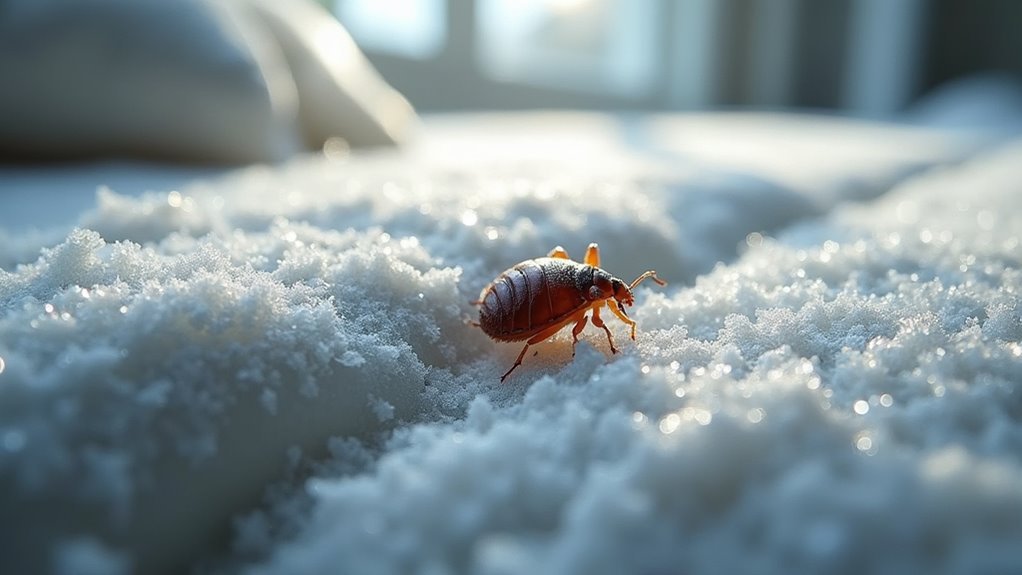
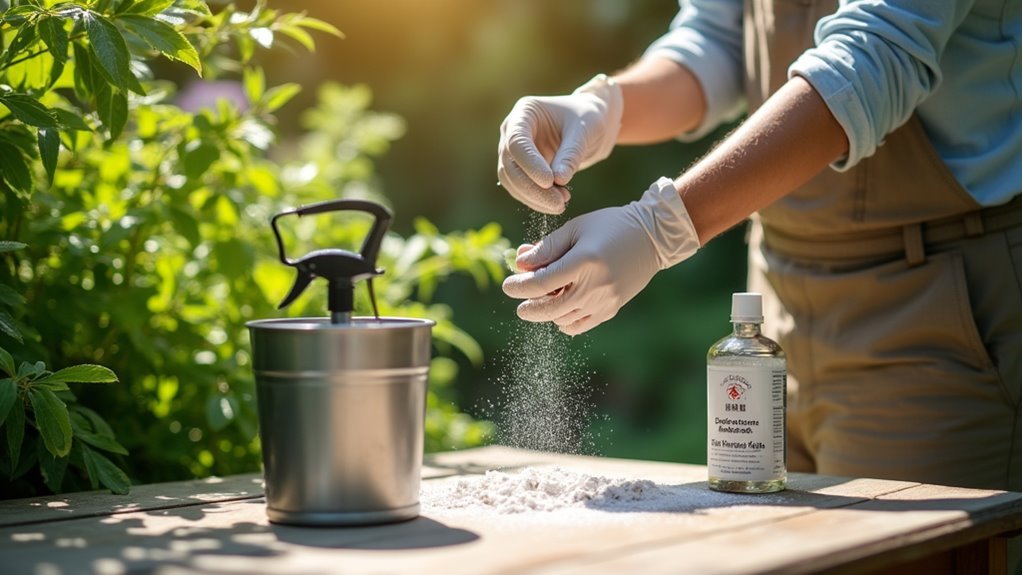


Leave a Reply